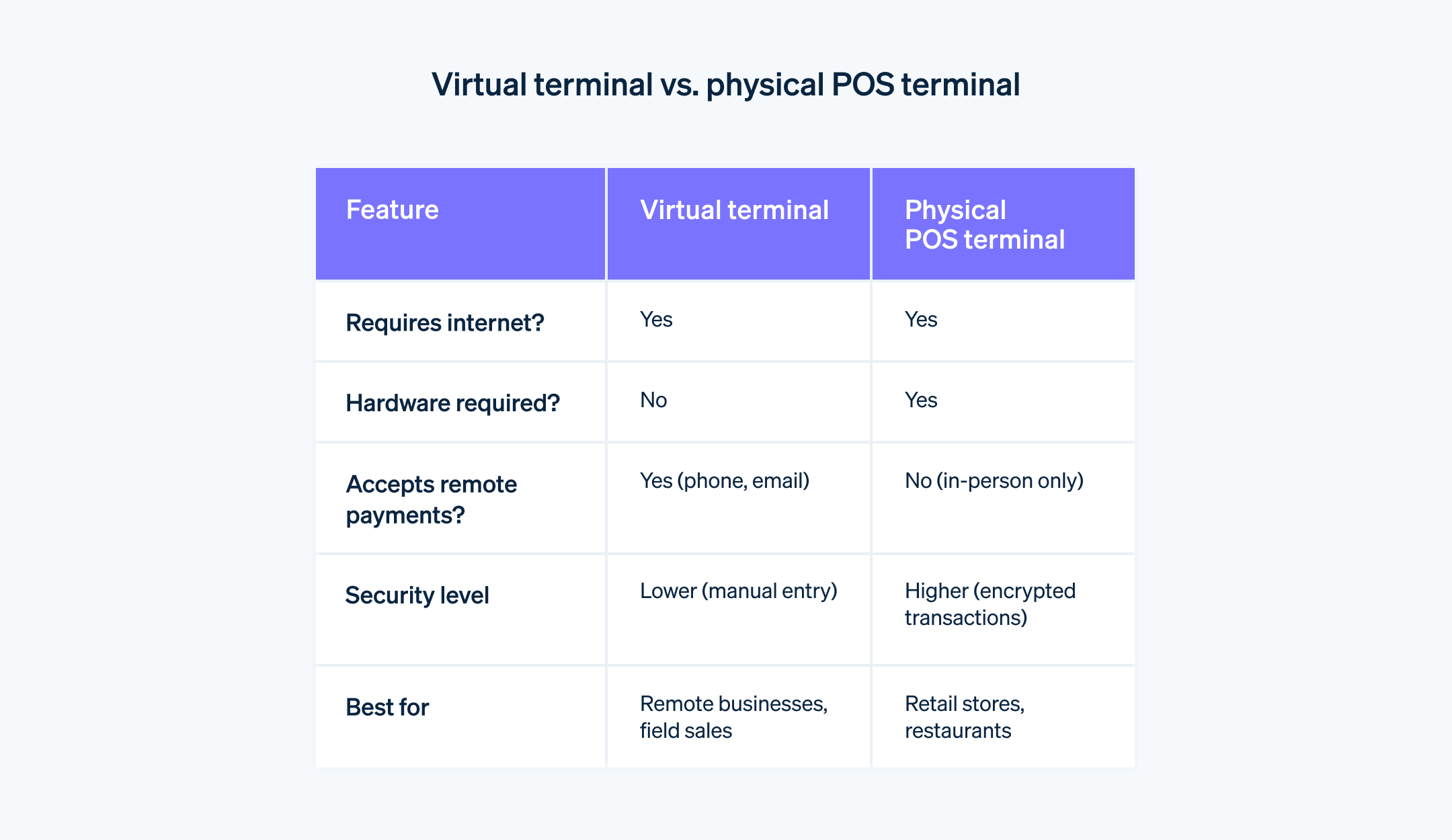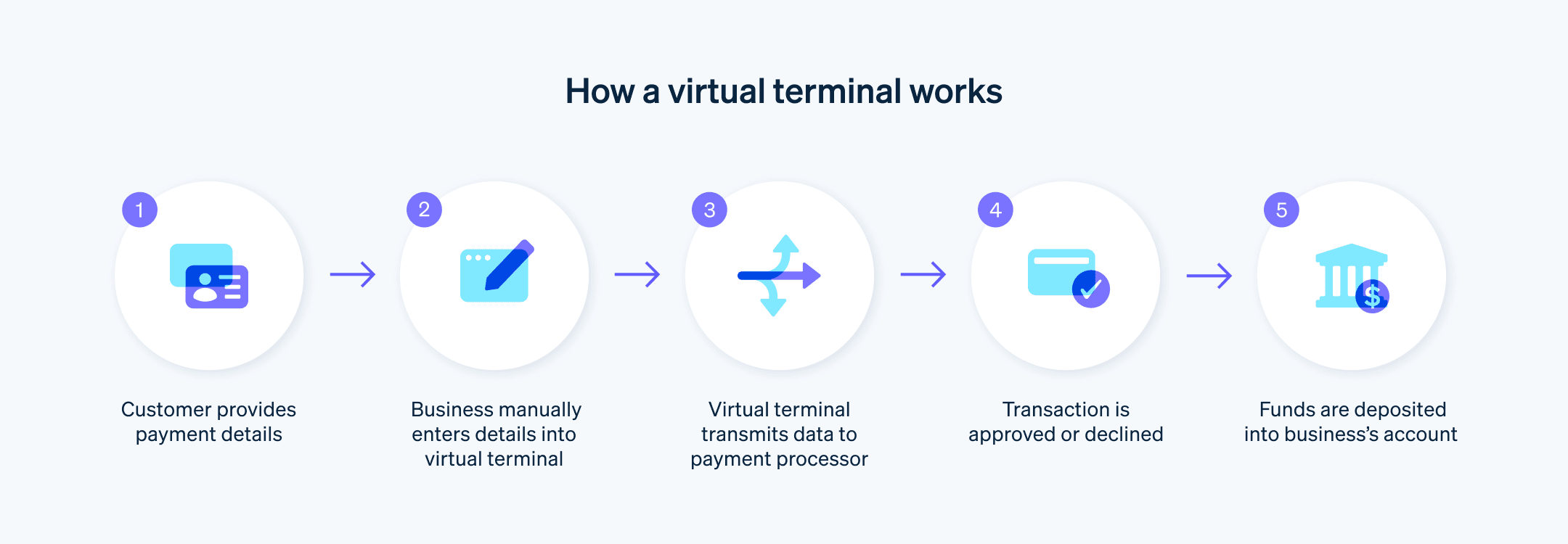Een cruciaal onderdeel van het opbouwen van een succesvolle onderneming is het creëren van een betalingsecosysteem dat klaar is om altijd en overal betalingen van klanten te accepteren en transacties te verwerken. Hoe zit het met verkopen die op je pad komen als je geen toegang hebt tot je gebruikelijke terminals voor het verwerken van betalingen?
Dan komen virtuele terminals goed van pas. Voor de meeste gebruikers is een virtuele terminal geen standaard onderdeel van hun arsenaal aan betalingen, maar het kan wel een belangrijk onderdeel zijn.
We bespreken wat een virtuele terminal is, hoe deze werkt, waarom je er mogelijk een moet gebruiken en wat Stripe-gebruikers moeten weten over het instellen van een terminal.
Wat staat er in dit artikel?
- Wat is een virtuele terminal?
- Hoe werkt een virtuele terminal?
- Welke soorten ondernemingen gebruiken virtuele terminals?
- Voordelen van het gebruik van virtuele terminals (en het enige grote risico)
- Biedt Stripe een virtuele terminal aan?
Wat is een virtuele terminal?
Virtuele terminals werken met webgebaseerde software, waardoor je betalingen elektronisch kunt verwerken zonder dat je een fysieke POS-terminal (POS) hoeft te gebruiken. Zelfs voor gebruikers die normaal gesproken POS-terminals gebruiken, bieden virtuele terminals een andere manier om klanttransacties uit verschillende bronnen te verwerken wanneer traditionele betaalterminals niet beschikbaar zijn.

Hoe werkt een virtuele terminal?
Ondernemingen kunnen virtuele terminals gebruiken om betalingen van klanten te accepteren via telefoon, e-mail, fax of persoonlijk via een apparaat met internet, zoals een laptop, tablet of smartphone. De meeste virtuele terminals accepteren creditcards en betaalpassen, evenals ACH-betalingen. In tegenstelling tot fysieke transacties die met een kaartlezer worden gedaan, moet de gebruiker bij virtuele terminals de transactie$en betaalgegevens handmatig invoeren.

Welke soorten ondernemingen gebruiken virtuele terminals?
De meeste ondernemingen die betalingen van klanten accepteren, kunnen baat hebben bij toegang tot een virtuele terminal. Met een virtuele terminal als onderdeel van je algehele betalingsconfiguratie hoef je nooit een onverwachte transactie uit te stellen, zelfs als je deze niet vaak gebruikt. En voor veel ondernemingen kunnen virtuele terminals ideaal zijn voor de dagelijkse activiteiten. Hier zijn een paar voorbeelden:
Horeca
Het is niet ongebruikelijk dat restaurants en andere gebruikers die maaltijden verkopen, bestellingen van klanten online, telefonisch en persoonlijk accepteren, allemaal binnen dezelfde tijdspanne van minuten. Virtuele terminals kunnen dienen als een belangrijk onderdeel van het algehele betalingssysteem van een restaurant: een systeem dat is ingesteld om transacties van verschillende invoerbronnen te verwerken.Detailhandel
Retailers die in verschillende omgevingen verkopen, kunnen ook profiteren van virtuele terminals. Als je bijvoorbeeld handgemaakt keramiek verkoopt en een permanente fysieke locatie hebt, maar ook regelmatig verkoopt op beurzen of informeel aan vrienden, kun je met een virtuele terminal overal betalingen verwerken.Freelancers en consultants
Als je een freelancer of consultant bent die klanten zelden in levende lijve ziet, denk aan schrijvers, ontwerpers, accountants en talloze anderen, kun je met een virtuele terminal eenvoudig betalingen accepteren zonder te investeren in fysieke POS-terminals en kaartlezers die je uiteindelijk misschien niet gebruikt.
Voordelen van het gebruik van virtuele terminals (en het enige grote risico)
De voordelen van het altijd en overal kunnen verwerken van klanttransacties liggen voor de hand, maar dit gemak is niet zonder risico. Hier volgt een overzicht van de voor$en nadelen van het gebruik van een virtuele terminal om betalingen te verwerken:
Voordelen
- Gemak
Virtuele terminals werken op elk apparaat met een internetbrowser. Omdat de meeste mensen hun smartphone altijd bij zich hebben, zijn virtuele terminals gemakkelijk toegankelijk. - Flexibiliteit
Virtuele terminals kunnen in bijna elke omgeving worden gebruikt om betalingen van verschillende bronnen te accepteren: persoonlijk, telefonisch, per e-mail of zelfs per post. - Leg verkopen vast die anders verloren zouden gaan
Het grootste voordeel van virtuele terminals is dat ze bedrijfseigenaren (of aangewezen werknemers) de mogelijkheid geven om gemakkelijk een klanttransactie uit te voeren, zelfs als ze niet in de buurt zijn van de fysieke of online betaalterminal van de onderneming. Dit betekent dat je onderneming geen omzet misloopt doordat een betaling niet kan worden verwerkt. Een potentieel verlies van niet alleen omzet, maar ook van customer lifetime value (LTV).
- Gemak
Risico's
- Zorgen over de beveiliging
Het belangrijkste argument tegen virtuele terminals is hun beveiliging. Bij fysieke kaartbetalingen die worden gedaan met een kaartlezer, stuurt de kaartlezer de kaartgegevens veilig naar de POS van de gebruiker en vervolgens naar de betalingsverwerker. Vaak wordt deze informatie versleuteld wanneer deze voor autorisatie wordt verzonden. Bij online transacties waarbij geen fysieke kaart wordt overlegd, voert de klant zijn betaalgegevens in, zoals het kaartnummer, de CVV-code en het factuuradres. Bij handmatige betalingen met een virtuele terminal voert de gebruiker de betaalgegevens in, wat per definitie minder veilig is dan bij andere betaalmethoden.
- Zorgen over de beveiliging

Biedt Stripe een virtuele terminal aan?
Ondernemingen die Stripe gebruiken, kunnen een virtuele terminal toevoegen aan hun Stripe-platform. Ze maken echter geen deel uit van de kant-en-klare oplossingen van Stripe, vooral omdat ze het moeilijker maken om te voldoen aan onze compromisloze normen voor beveiliging en PCI-DSS-compliance.
Als je een virtuele terminal aan je Stripe-account wilt toevoegen, heb je een API nodig. Wij kunnen je helpen deze voor je in te stellen. Nadat je je virtuele terminal hebt aangemaakt, kun je deze vanuit elke browser openen via je Stripe -dashboard. Ons doel is om een evenwicht te vinden tussen de mogelijkheid van een onderneming om altijd en overal betalingen te accepteren en er tegelijkertijd voor te zorgen dat betalingen zo veilig mogelijk zijn. Om hoge veiligheidsnormen te handhaven, moeten betalingen met een virtuele terminal worden beschouwd als een nuttige, maar zeldzame back-upmethode voor het accepteren van betalingen via e-mail, fax of telefoon.
De inhoud van dit artikel is uitsluitend bedoeld voor algemene informatieve en educatieve doeleinden en mag niet worden opgevat als juridisch of fiscaal advies. Stripe verklaart of garandeert niet dat de informatie in dit artikel nauwkeurig, volledig, adequaat of actueel is. Voor aanbevelingen voor jouw specifieke situatie moet je het advies inwinnen van een bekwame, in je rechtsgebied bevoegde advocaat of accountant.